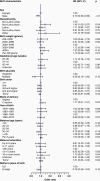Birth characteristics and risk of meningioma in a population-based study in California
- PMID: 36479059
- PMCID: PMC9721385
- DOI: 10.1093/noajnl/vdac173
Birth characteristics and risk of meningioma in a population-based study in California
Abstract
Background: We evaluated the potential role of birth characteristics in the etiology of early-onset meningioma.
Methods: Leveraging a population-based linkage of California birth records (from 1978 to 2015) and cancer registry data (from 1988 to 2015), we identified 362 nonmalignant meningioma cases aged 0-37 years and selected 18 100 controls matched on year of birth. Cases and controls were compared with regard to birth characteristics, with adjusted odds ratios (ORs) and 95% confidence intervals (CIs) estimated from unconditional multivariable logistic regression models. We also conducted stratified analyses by race/ethnicity and age.
Results: Female sex (compared to male: OR = 1.43, 95% CI: 1.16 to 1.79; P < .01) and Black race (compared to White: OR = 1.46, 95% CI: 1.02 to 2.07; P = .04) were associated with higher risk of meningioma. Higher birth order (OR = 0.90, 95% CI: 0.81 to 0.99 per additional birth position; P = .04) was associated with a lower risk. No significant associations were observed between birthweight, gestational age, delivery mode, maternal age, or maternal education and meningioma risk. In the non-Latino White subgroup, higher birthweight was associated with a higher risk of meningioma (OR = 1.20, 95% CI: 1.02 to 1.41 per 500 grams; P = .03), but this was not recapitulated in the Latino subgroup. In age-stratified analyses, female sex was a risk factor for those diagnosed at the age of 20-37 years but not among younger individuals.
Conclusions: In this large population-based study less prone to selection and recall bias, higher birth order was associated with a reduced risk of early-onset meningioma, while female sex and Black race were linked to an increased risk. There were also indications of differential associations by race/ethnicity and age of diagnosis.
Keywords: birth characteristics; birth order; birthweight; epidemiology; meningioma.
© The Author(s) 2022. Published by Oxford University Press, the Society for Neuro-Oncology and the European Association of Neuro-Oncology.
Figures

Similar articles
-
Association between birth characteristics and incidence of pituitary adenoma and craniopharyngioma: a registry-based study in California, 2001-2015.Cancer Causes Control. 2023 Sep;34(9):757-768. doi: 10.1007/s10552-023-01718-7. Epub 2023 May 25. Cancer Causes Control. 2023. PMID: 37225897 Free PMC article.
-
Birth Characteristics and Risk of Pediatric Thyroid Cancer: A Population-Based Record-Linkage Study in California.Thyroid. 2021 Apr;31(4):596-606. doi: 10.1089/thy.2020.0217. Epub 2020 Oct 7. Thyroid. 2021. PMID: 32912083 Free PMC article.
-
Adolescent pregnancy: understanding the impact of age and race on outcomes.J Adolesc Health. 1997 Mar;20(3):187-97. doi: 10.1016/S1054-139X(96)00174-7. J Adolesc Health. 1997. PMID: 9069019
-
Birth characteristics and risk of Ewing sarcoma.Cancer Causes Control. 2023 Oct;34(10):837-843. doi: 10.1007/s10552-023-01737-4. Epub 2023 Jun 19. Cancer Causes Control. 2023. PMID: 37335392 Free PMC article.
-
Mode of Delivery, Birth Characteristics, and Early-Onset Non-Hodgkin Lymphoma in a Population-Based Case-Control Study.Cancer Epidemiol Biomarkers Prev. 2021 Dec;30(12):2286-2293. doi: 10.1158/1055-9965.EPI-21-0535. Epub 2021 Sep 20. Cancer Epidemiol Biomarkers Prev. 2021. PMID: 34548330
Cited by
-
Prenatal exposure to per- and polyfluoroalkyl substances (PFAS) from contaminated water and risk of childhood cancer in California, 2000-2015.Environ Epidemiol. 2025 Jan 9;9(1):e365. doi: 10.1097/EE9.0000000000000365. eCollection 2025 Feb. Environ Epidemiol. 2025. PMID: 39802752 Free PMC article.
-
Racial distribution of molecularly classified brain tumors.Neurooncol Adv. 2024 Aug 2;6(1):vdae135. doi: 10.1093/noajnl/vdae135. eCollection 2024 Jan-Dec. Neurooncol Adv. 2024. PMID: 39220243 Free PMC article.
-
The joint impacts of sex and race/ethnicity on incidence of grade 1 versus grades 2-3 meningioma across the lifespan.Neurooncol Adv. 2023 Jun 3;5(Suppl 1):i5-i12. doi: 10.1093/noajnl/vdad020. eCollection 2023 May. Neurooncol Adv. 2023. PMID: 37287573 Free PMC article.
